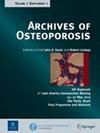骨折的全球负担及其潜在病因:来自2021年全球疾病负担研究的结果和进一步分析
摘要
骨折会导致生活质量和护理需求的下降,所有这些都会严重影响患者及其家属。我们的研究结果显示,全球范围内骨折的发生率、患病率和死亡率在两性中都有所上升。应制定优先避免不同解剖部位骨折的政策。背景:骨折是疾病负担的主要因素,预计在未来几年将显著上升。本研究的目的是估计全球骨折负担,并分析1990年至2021年间骨折病因的变化。方法:基于全球疾病负担(GBD) 2021收集的信息,本研究按性别、年龄组、解剖部位、GBD地区、SDI地区和国家分析1990年至2021年间骨折的数量、年龄标准化发生率、患病率和残疾生存年限(YLD)。我们使用估计年百分比变化(EAPC)来计算过去30年的年龄标准化率的趋势。结果:2021年新发骨折17279万例(95%UI 158.38 ~ 187.65),其中女性7766万例(95%UI 70.53 ~ 85.15),男性9512万例(95%UI 87.69 ~ 102.67)。全球流行病例为45331万例(95%UI 421.17-486.12)。2021年各年龄层骨折造成的yld为2518万(95%UI 17.28-34.62),呈上升趋势,EAPC为1.1。然而,从1990年到2021年,骨折的年龄标准化发病率(ASIR)、年龄标准化患病率(ASPR)和年龄标准化伤残年数(ASYR)普遍下降。2021年骨折ASIR、ASPR、ASYR分别为2172.52例(95%UI 1995.20 ~ 2364.46) / 10万人口,5397.67例(95%UI 5022.63、5787.16)/ 10万人口,300.19例(95%UI 205.86 ~ 412.53) / 10万人口。与其他国家和地区相比,2021年骨折ASIR最高的是新西兰(6197.81例(5391.24-7068.78)/ 10万人口),其次是斯洛文尼亚共和国(5996.53例(5367.82-6640.29)/ 10万人口)和澳大利亚(5420.39例(4684.64-6301.56)/ 10万人口)。即使我们观察到男性比女性有更多的偶发、普遍和YLDs骨折病例;和较高的ASIR、ASPR和ASYR,它可能不适用于不同解剖部位的骨折,如髋部骨折和桡骨和/或尺骨骨折。此外,我们的研究显示,在55-59岁、85-89岁和70-74岁年龄段,女性的ASIR、ASPR和ASYR高于男性,尽管女性和男性的ASPR和ASYR都随着年龄的增长而上升。跌倒是全球范围内ASYR 3级骨折的主要原因,但呈下降趋势;道路伤害和机械力暴露分别是导致骨折的第二和第三大原因。结论:在过去的30年里,骨折的发病率、患病率和YLDs病例呈上升趋势,骨折仍然是一个主要的全球负担。此外,尽管高SDI区域骨折的ASIR、ASPR、ASYR呈下降趋势,但在5个SDI区域中始终保持第一的位置。对于55 ~ 59岁的女性,应提高认识,以降低骨折的发生率。在制定政策时应考虑抗骨质疏松药物,改善生活习惯和多种预防跌倒策略。Summary
Fractures can result in decreased quality of life and care requirements, all of which significantly affect patients and their families. Our results revealed that the global incident, prevalent, and YLDs cases of fractures have risen in both sexes. Policies that prioritize avoiding fractures at different anatomical sites should be developed.
Background
Fractures are a major contributor of disease burden and are predicted to rise significantly in the years to come. The purpose of this study was to estimate the global burden of fractures and analyze the changes of etiologies of fractures between 1990 and 2021.
Methods
Based on the information collected from the Global Burden of Disease (GBD) 2021, this study analyzed both the number and age-standardized rate of incidence, prevalence, and years lived with disability (YLD) of fractures between 1990 and 2021 by sex, age group, anatomical site, GBD region, SDI region, and country. We used estimated annual percentage changes (EAPC) to calculate the trends of the age-standardized rate over the past 30 years.
Results
In 2021, the number of new cases of fractures was 172.79 million (95%UI 158.38–187.65), with 77.66 million (95%UI 70.53–85.15) cases in females and 95.12 million (95%UI 87.69–102.67) cases in males. The prevalent cases were 453.31 million (95%UI 421.17–486.12) globally. In addition, fractures caused 25.18 million (95%UI 17.28–34.62) YLDs among all ages in 2021, displaying an increasing trend with an EAPC of 1.1. However, there was a general decline in the age-standardized incidence rate (ASIR), age-standardized prevalence rate (ASPR), and age-standardized years lived with disability rate (ASYR) of fractures from 1990 to 2021. The ASIR, ASPR, and ASYR of fracture in 2021 were 2172.52 cases (95%UI 1995.20–2364.46) per 100,000 population, 5397.67 cases 95%UI (5022.63, 5787.16) per 100,000 population, and 300.19 cases (95%UI 205.86–412.53) per 100,000 population. Compared with other countries and territories, New Zealand (6197.81 cases (5391.24–7068.78) per 100,000 population) had the highest ASIR of fractures in 2021, followed by the Republic of Slovenia (5996.53 cases (5367.82–6640.29) per 100,000 population) and Australia 5420.39 cases (4684.64–6301.56) per 100,000 population). Even while we observed that males had more incident, prevalent, and YLDs cases of fractures than females; and higher ASIR, ASPR, and ASYR, it may not apply to fractures at different anatomical sites, such as fracture of hip and fracture of radius and/or ulna. Furthermore, our study revealed that ASIR, ASPR, and ASYR for females were higher than males after the ages of 55–59, 85–89, and 70–74, although the ASPR and ASYR rose with age for both females and males. Falls were the leading ASYR level 3 cause of fractures worldwide, but with a downward trend; road injuries and exposure to mechanical forces were the second and third main causes of fractures.
Conclusions
Given the rising tendency of incidence, prevalence, and YLDs cases over the past 30 years, bone fractures continue to be a major global burden. In addition, despite the downward trend in ASIR, ASPR, and ASYR of fractures in the high SDI region, it consistently ranked first among the five SDI regions. Increased awareness should be paid to women after the ages of 55 to 59 to lower the incidence rate of fractures. Anti-osteoporotic medication, improving lifestyle habits and multiple-component fall prevention strategies should be considered while making policy.

 求助内容:
求助内容: 应助结果提醒方式:
应助结果提醒方式:


